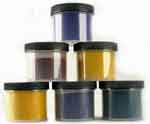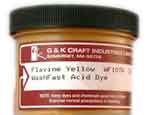Is Superwash treatment too toxic for my customers?
—ADVERTISEMENTS—
Acid Dyes for Wool and Other Protein Fibers

Lanaset Dyes are among the very best dyes for hand-dyeing wool, silk, angora, mohair, and most nylons. You will also need: citric acid, sodium acetate, Glauber salt, Albegal SET, and Synthrapol.
Buy from
Paradise Fibers
at Paradise Fibers

Washfast Acid dyes
Also known as Nylomine dyes, excellent for use on wool. One ounce of dye will dye six pounds of fiber!
Books with Instructions for Dyeing Wool
Country: United States
Message: Hi Paula,
I am a small-time wool yarn dyer. My business has been growing rapidly these past 1-2 years and now my customers are starting to request that I carry more superwash yarns (I currently carry a small amount of Superwash sock yarns). I am hesitant to add more Superwash, as I understand that the Superwash process is quite toxic. I see from an article on your site that you believe it's toxic as well. I read on Ravelry that the Superwash processes are so toxic that they are outlawed in this country and that most Superwash yarn comes from China. Do you know if this is true? I was also wondering if you know of any yarn or fibers that can be dyed with acid dyes, don't felt, and are NOT Superwash? So far I haven't found anything--with the exception of silk (but I am not using silk for ethical reasons).
Hi Morwenna,
This has taken me a while to respond because it's a complicated issue. I've had to do a lot of research, and I can't really condense it into a brief answer.
First, I do not believe that the Superwash wool we can buy is toxic to wear or to work with. If the problem is your concern for the health of your buyers, there's no reason not to carry it. The only reasons not to carry Superwash wool are ideological, due to either a preference for locally sourced materials or a concern with the production of environmental waste. Even the most vehemently anti-Superwash industrial source concedes that garments made from this wool do not pose any risk to the consumer.
What is toxic is the process of making it. I wrote previously that I don't want anyone to try to produce Superwash wool at home by chemically treating virgin wool. To be done safely, the Superwash process requires industrial equipment and methods that hand-dyers do not have access to. If your concern is toxicity to the wearers of the garments made with SuperWash wool, or the crafters who are working with it, then you do not need to worry.
The chemicals used in the Superwash treatment cannot have been outlawed in the US for safety reasons, because, in fact, they are also used for a number of other industries which are still located in the US! The chlorination process that removes the tips of the scales can be performed with hypochlorite, which is the active ingredient in ordinary household bleach, or with dichloroisocyanuric acid, which is commonly used to chlorinate swimming pools and is found in Comet scrubbing powder, or with chlorine gas, which is commonly used in water purification facilities. An increasingly popular alternative to the chlorine compounds used for this process is ozone2, in order to reduce the costs of wastewater disposal; while ozone is itself highly toxic, ozone-treated textiles can be safe. Other alternatives include peroxy compounds and enzymatic processes. The polyamide-epichlorohydrin which is used in a thin resin coating on the fibers in most Superwash wool is also used in the paper industry and in the production of glycerin and epoxy resins.3 The United States is one of the two largest producers of epichlorohydrin in the world.4 A 2009 industry publication points out that consumption of polyamide-epichlorohydrin resins is growing in the US every year, largely due to demand for soft facial tissues and sturdy disposable paper towels.5
There are many chemical and industrial processes that have moved to China for economic reasons. The factories that process Superwash wool are located in areas that produce a lot of wool, such as South Africa6, and also in Germany7; the latter is worth noting because of the strict environmental protection rules in Germany. China, perhaps surprisingly, is the world's second-largest producer of wool. I've read that the amount of wool produced in the US, less than 1% of worldwide production8, is not large enough to make a Superwash production facility here economically feasible.
The amount of organic chlorine compounds in wastewater is an issue. The Patagonia clothing company claims in their promotional materials9 that the chlorinated chemicals in wastewater from Superwash processing of wool are not accepted by American wastewater treatment plants, but that claim is not altogether convincing, given that there are other industries in the US producing the same sorts of organic halogen waste, and also that Germany's rules in general appear to be stricter than those in the US, and yet they do make Superwash wool. Furthermore, the use of the ozone method to replace chlorination avoids the whole problem of organic chlorine compounds in wastewater.
On another page10, the Patagonia people make a claim that the process of chlorinating wool is so toxic that it's illegal in the US; I cannot find any evidence for that, and believe that the claim must be the result of distortion by an advertising copywriter who is more concerned about sales than truth. Perhaps they were referring to the fact that it is illegal to discharge certain pollutants without appropriate treatment. This may be the source for the wilder claims you saw.
After the chemical processing required to make Superwash wool has been completed, the treated wool is no longer toxic. The chlorine-based chemicals are neutralized and washed off, and the resin coating is polymerized to a safe form. Many plastics that we use every day are safe in their polymerized form, but are made by linking together small chemicals that are very toxic in liquid form before polymerization. If your customers want Superwash wool, it will not harm them for you to supply it. You should, of course, make it clear which of your products have been treated, whether they were grown and spun in the US, and, if not, where they were imported from.
If you don't like the idea of the Superwash process, or of the possibility of environmental contamination at the factories that use it, then you'll want to look into other fibers. Unfortunately, I have not been able to find a source in any country for wool yarns that have been shrink-proofed with ozone, peroxy compounds, or enzyme treatments, although they are used by at least one large clothing company. Wool is the most prone to felting of all protein fibers, because of the scales on the outer layer, which lock together if there is too much agitation in the presence of heat and water. Other animal fibers are less prone to felting and may be more suitable for your needs. As a rule, however, other animal hair fibers will also felt if conditions are extreme enough. Mohair, angora, and cashmere are less prone to felting than wool is, but alpaca is more so. Felting can be avoided by refraining from stirring the wool in the hot dyebath. Agitation is not the only way to obtain level solid-color dyeing. Some dyes are more inclined toward level dyeing than others, and there are auxiliary chemicals that assist in leveling; these vary according to which dye you use.
If you don't want to use ordinary silk, in which the cocoons are steamed to kill the silkworms before they can cut the fibers, you can use silk from cocoons whose moths have been allowed to emerge naturally. The fibers are shorter, so you don't get the extraordinary fiber length seen in most silk, but these shorter fibers can be spun into yarn like other fibers. Aurora Silks sells several different types of "Peace" silk prepared in this way. For example, their Tussah silk yarns are a type of Peace silk.
Soy Silk is another fiber that can be dyed with acid dyes. Soy silk is a protein fiber made from soybeans, as the name implies. There is a fair amount of foolishness in the claims you sometimes see for Soy Silk, such as that it is a byproduct of the tofu industry or that it is produced in a "chemical free" process. It is likely that not all of the claims you see about the environmental wonderfulness of Soy Silk can be substantiated. How easily dyeable soy silk is will depend on how much it has been chemically modified. It's worth nothing that, just as with real silk, many dyers prefer to use fiber reactive dyes, rather than acid dyes, to dye Soy Silk.
If your customers are requesting Superwash wool, and yet you want to encourage the use of locally-sourced products, you may find that you have a greater effect by keeping these people as your customers by giving them what they want, while promoting other products to them, than by not carrying the products they've requested. You'll want to label each of your yarns according to country of origin, if you can even find this information. It's certainly worthwhile to seek out and promote relatively local sources of wool yarns, if only to encourage the survival of American wool farmers.
(Please help support this web site. Thank you.)
Posted: Thursday - November 19, 2009 at 09:04 AM
Follow this blog on twitter here.
- Top of this blog -
- FAQ -
- The Dye Forum -
- How to Tie Dye - How to Batik -
- Books - Toys - Plants -
More in this category:
- -
Total entries in this category:
Published On: Aug 29, 2012 02:47 PM